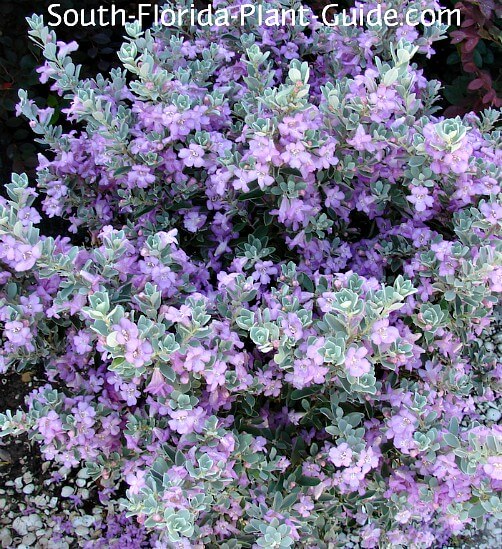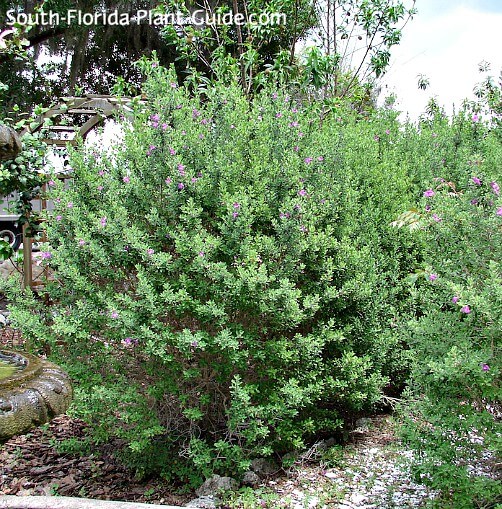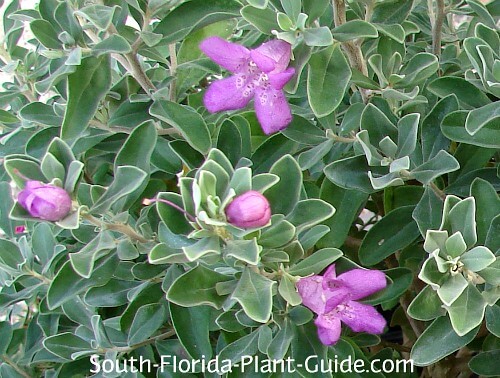Texas Sage
Leucophyllum frutescens
Handsome and hardy, Texas sage is an outstanding South Florida landscape choice with its silvery foliage, purple flowers and drought-tolerant nature.

The lavender to purple blossoms appear on and off all year amidst small, soft, silver or gray-green leaves.
Though not a true sage, this shrub is easy care and doesn't like to be fussed over.
In fact, this is one plant where too much care - water, fertilizer, trimming - can actually be detrimental to its health.
A native of Texas and the arid southwest, Texas sage is called the Barometer Plant there, because as soon as the humidity begins to rise after very dry weather, this shrub bursts into bloom.
This is an excellent plant for those areas so dusty and dry nothing wants to grow there. The silver foliage - not to mention the pretty flowers - makes it stand out in a landscape of green-green-green.

Plant specs
This is a slow-growing shrub that prefers full sun, You can keep it 3 to 5 feet tall.
These plants are cold hardy, doing well in Zone 9B and southward.
They're evergreen, moderately salt-tolerant, and drought-tolerant once established.
Plant care
Choose a well-drained area or this plant won't survive. Plant it a little on the high side, mounding dirt up to it, to make sure there's good drainage even during our rainy season.
No soil amendments are necessary.
Because it's a slow grower, trimming occasionally (do it after a bloom cycle has finished) should be all that's needed to keep this shrub the size and shape you want.

Shearing using hedge trimmers can eventually cause Texas sage to thin
out from within...better to leave its natural shape pretty much alone.
Once
the plant matures, however, it can grow a bit scraggly. Do a hard
pruning in spring (late March or early April), cutting the branches at
alternate lengths rather than chopping the whole thing back.
It will flush out nicely once it grows out of the pruning...which will take a while because of the slow rate of growth.
Give
it regular irrigation to get it established, making sure there's enough
time between waterings for the plant to dry out. Once it's established,
water during dry spells.
This plant doesn't like a lot of fertilizer. At the most, fertilize only 1 or 2 times a year, applying a good granular fertilizer in spring and/or fall.
Plant spacing
Place these shrubs about 3 feet apart. Come out from the house 3 feet.
If you're planting along a drive or walk, come in 3 or 4 feet.
This shrub does fine in a large container.
Landscape uses for Texas sage
- hedge
- accent
- privacy screen
- single yard specimen
- shrub for the corner of the house
- backdrop for smaller plants
- lining a walkway or drive
- around a deck, porch or patio
- along a fence
- surrounding tall palms
A.K.A. (also known as): Silverleaf, Texas Ranger
GOOD SNOWBIRD PLANT? YES
COMPANION PLANT SUGGESTIONS: Mix with other sun-loving plants that like it on the dry side, such as ice plant, crown of thorns, jatropha, Muhly grass, clusia, carissa, cycads, Knock Out rose, and frangipani.
Other plants you might like: Ligustrum Sinensis, Yesterday Today & Tomorrow
Take a break!
The ultimate guide to low-maintenance plants
and landscaping!
An ebook by
Chase Landre
author of
South-Florida-Plant-Guide.com
Learn more!
Get a greener thumb!
Want to learn more about South Florida planting, watering, fertilizing and dealing with weeds and pests?
See our Gardening How-To section for answers!
Get instant curb appeal!
An ebook by
Chase Landre
author of
South-Florida-Plant-Guide.com
Learn how to get instant curb appeal with fast growing plants and landscaping techniques!



